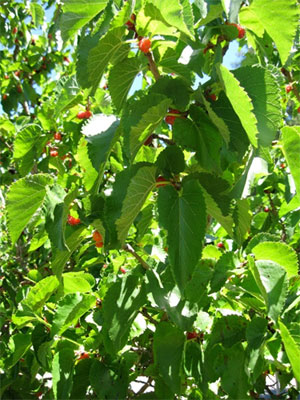Our Mulberry Tree! Early this morning I trudged out under the foggy sky and picked all I could from our one mulberry tree. Last week I had only gotten two handfuls; now I filled a small bucket. As juice dripped down my arm I realized how the darkest berries were hidden behind and between the leaves, best found by standing under them. (So often the best things in life are right under our noses but take a shift of perspective to see!) So I put my back to the trunk, stuck my head between the branches and happily picked away. The berries practically fell into my can with the touch of a finger. I had thought of baking a pie but couldn’t wait — they just had to go into my breakfast bowl. Yum. Mulberry trees provide amazing herbal medicine. All parts are used and they host mistletoe, too (Loranthus parasiticus; sang ji sheng). The mulberry tree is a pharmacopoeia in itself, and is amazing for how its many parts are widely used for such different purposes. (This may be due to the Chinese interest in the silk worm, which feeds on the tree, and since the Chinese are the major producers of silk in the world, they learned a great deal about the tree). The mulberry tree is an excellent study in how each part of a plant works uniquely, particularly when prepared in different ways. It’s also a lesson in Chinese; note how sang is the word for mulberry, while the words following it are names for each of the plant parts:
- fruit: sang shen
- leaf: sang ye
- twigs: sang zhi
- root bark: sang bai pi
Indications: Fruit: dizziness, tinnitus, insomnia, premature graying hair, constipation due to Deficient Blood, wasting and thirsting disorder (diabetes, TB) Leaf: fever, headache, sore throat, cough with thick, yellow phlegm, dry mouth, red, sore, dry or painful eyes, spots in front of eyes, vomiting of blood due to Heat in Blood Twigs: edema, arthritis, rheumatism and painful joints, especially in the upper extremities Root bark: coughing and wheezing due to Lung Heat (yellow mucus and inflammation), edema, facial edema, swelling of extremities, fever and thirst, difficulty in urination, hypertension
MULBERRY
Morus alba; Moraceae C, W Parts Used:fruit, leaf, twigs, root bark Energy, taste and Organs affected: Fruit: cold; sweet; Heart, Liver, Kidney Leaf: cold; sweet, bitter; Liver, Lung Twigs: slightly cold; bitter, sweet; Liver Root bark: cold; sweet; Lung, Spleen Actions: Fruit: tonifies Blood Leaf: cools and releases the Exterior Twigs: dispel Wind and Dampness Root bark: relieves coughing and wheezing Properties: Fruit: demulcent, nutritive Leaf: diaphoretic Twigs: antirheumatic, antispasmodic Root bark: expectorant, antitussive Biochemical constituents: Fruit: carotene, thiamene, riboflavin, Vitamin C, tannin, linoleic acid, stearic acid Leaf: carotene, succine acid, adenine, choline, amylase Twigs: mulberrin, mulberrochromene, cyclomulberrin, morin, cudranin, maclurin, cyclomulberrochromene, tetrahydroxystilbene, dihydromorin, dihydrokaempferol, fructose, glucose, arabinose, xylose, stachyose, sucrose Root bark: morusin, mulberrin, mulberrochromene, cyclomulberrin, cyclomulberrochromene Dose: infuse leaves, decoct the rest: Fruit: 6-15 g; often used in syrup form Leaf: 4.5-15 g; toast in honey for cough or Lung Dryness; external wash for eyes Twigs: 10-30 g; often the old stems are used Root bark: 6-15 g; honey-fry to stop coughing and wheezing Precautions: Fruit: diarrhea due to Spleen Deficiency Leaf: none noted Twigs: none noted Root bark: excessive urination, cough due to Wind Cold Other: Loranthus (Loranthus parasiticus; sang ji sheng), the mistletoe growing on the mulberry tree, is a Yin tonic used to treat low back and muscle pain, arthritis, rheumatism and hypertension.

